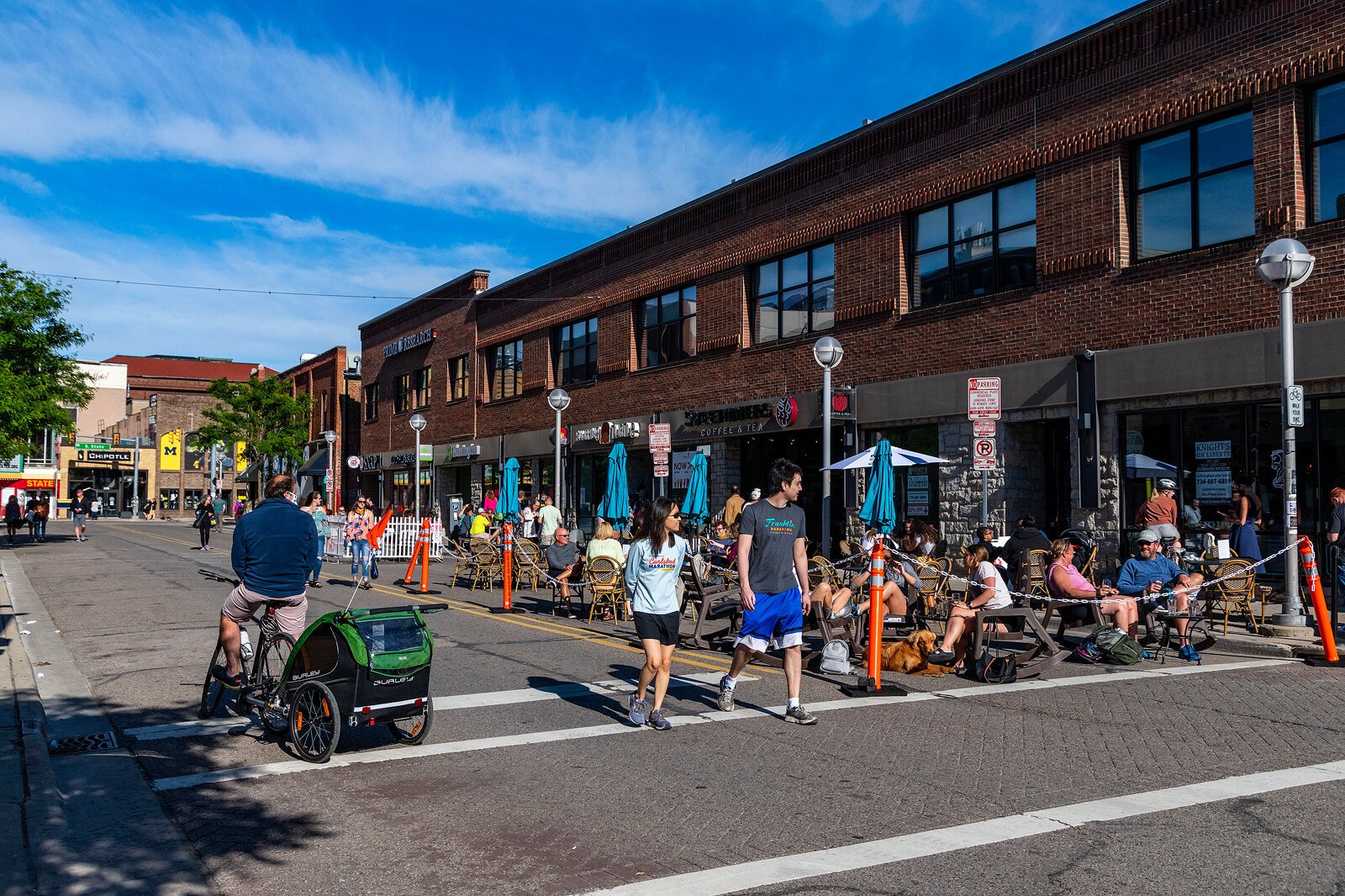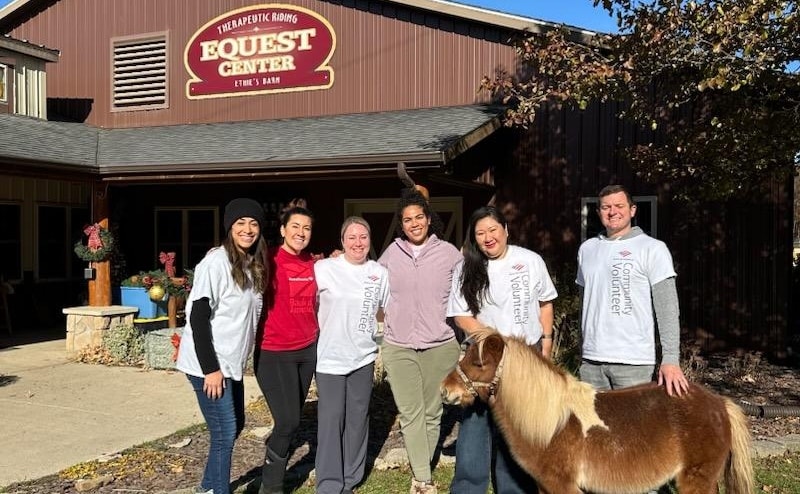Several communities have closed select streets to automobiles, and advocates hope that the pandemic may prompt long-term positive changes in how we use public space for health and fitness.
This article is part of State of Health, a series about how Michigan communities are rising to address health challenges. It is made possible with funding from the Michigan Health Endowment Fund.
After Gov. Gretchen Whitmer issued Michigan’s stay-home order in March, car traffic in Ann Arbor dropped by 59%. With gyms and fitness centers closed, residents took experts’ advice and began walking, biking, and getting more outdoor exercise. These two changes led Molly Kleinman, chair of the Ann Arbor Transportation Commission, to a logical conclusion: Why not designate select streets as open streets, where automobile traffic is restricted or prohibited to provide more space for people to walk, run, and bike?
“For people to be able to get outside to exercise — to walk, run, ride bikes — there is simply not enough space to maintain the six-foot minimum for safe social distancing,” Kleinman says.
Though Ann Arbor’s traffic has dropped since the pandemic hit, the rate of automobile accidents has remained the same, indicating that motorists are traveling at higher speeds that put cyclists and pedestrians at higher risk.
“Public health officials emphasized the importance of getting outside and getting physical activity to preserve mental health during a very difficult and stressful time,” Kleinman says. “As weather is warmer, the desire to be outside has increased tremendously. We have a real responsibility to ensure that people can do that as safely as possible.”
Ann Arbor recently began closing several main thoroughfares every weekend, and it’s just one of several Michigan communities that are experimenting with open streets this summer. The term “open streets” is often applied to closing streets to automobile traffic for one day or a weekend so communities can participate in some type of special event, but the pandemic is prompting some communities to make it more of a standard practice. These changes have often been discussed as a way to boost commerce, with restaurants and bars expanding their patios into the streets, but the implications for health and fitness are also significant.

“I think it’s going to be a time for experimentation, a bit of an opportunity to see if, gosh, maybe we could think of our public space a little differently,” says Bradley Neumann, Michigan State University Extension senior extension educator. “Not just parks and open space, but all these miles and miles of streets that are public domain. Maybe we can use that space for more active transportation that gets at those goals of being a more physically fit and healthier state. COVID-19 certainly presents an opportunity, an impetus to convert some of these spaces.”
Neumann also notes that Michigan’s 2010 Complete Streets legislation requires communities to design streets and right-of-ways that safely meet the needs of all legal uses — cars, transit, cyclists, pedestrians, and people with disabilities. He cites Grand Rapids, Petoskey, and Traverse City as municipalities that have made good strides forward.
“Michigan has a long way to go with the car mentality,” he says. “If you travel to other states, even neighboring states, you see more people walking around or cycling. They have a different car culture. Cyclists do have the right to be in the street. This could be another opportunity to remind motorists that pedestrians and cyclists need to be in this space.”
As the COVID-19 pandemic shifts attitudes about public space to prioritize physical fitness and health, open, shared, and complete streets could provide the necessary real estate at very little cost.
Traverse City a shared streets leader
Traverse City will open two blocks of its downtown Front Street to pedestrians only June 24 through Labor Day. This open street will provide people visiting downtown shops and restaurants space for safe social distancing. While promoted as a way to boost businesses during the pandemic, resident Gary Howe hopes the community also realizes the associated health and fitness benefits. As advocacy director for Norte, a Traverse City organization that works to build pedestrian- and bike-friendly communities, Howe has also served as a Traverse City commissioner and planning commission member.
“I tend to walk in the street anyways,” Howe admits. “This [open street] is more of a nudge. One more layer of awareness. Some folks would like it to be permanent, perhaps seasonally. We have a rich history of pilot projects turning into permanent projects.”
Howe says Traverse City has excelled at making neighborhoods safe for pedestrians and bicyclists. Traffic calming measures have created many shared streets. One year-long pilot project that allowed on-street parking 24/7 in a certain neighborhood had great results.
“Not only were cars going slower, neighbors got to know each other more,” Howe says. “Traverse City is doing a good job of shifting that narrative. Last year, we installed our first protected bike lane. On major streets, bike traffic can be very contentious. The consensus was that if the bikes are safe and out of your lane, you’ll be able to drive more smoothly. We changed peoples’ perspectives.”
Shared streets are more equitable streets
The push for open, shared, and/or complete streets is also a push for health equity. In urban settings, low-income neighborhoods, most often communities of color, often lack walking and biking infrastructure. Social distancing exacerbates this lack of access.
“Lower-income neighborhoods are less likely to have access to space for kids to play and people to get exercise. The configuration of housing is less likely to have yards and pedestrian infrastructure like sidewalks and marked crosswalks. We need to make outside spaces for all of our residents so people can go out and get exercise in their own neighborhoods safely,” Kleinman says.
She adds that the streets are never truly “open” for these communities because of jaywalking laws and how they’re enforced.
“There is a much higher potential that people of color will be arrested for breaking those laws,” Kleiman says. “This is something we can do to remove that potential.”
Kleinman also recognizes that Michigan’s lower-income neighborhoods tend to have more exposure to air pollution from cars, among other sources.
“There is a strong connection between air pollution and health. COVID-19 is a respiratory illness,” she says. “We’re seeing that again when we talk about equity. African-Americans and our low-income neighbors are being hit disproportionately by COVID-19.”
As streets become safe for walking and biking, people will drive less and those carbon emissions will decrease. Kleinman notes that this could help Ann Arbor achieve the goals of its 2012 Climate Action Plan.
“One of the real stretch goals, which seemed very challenging at the time, was to cut car trips by 50%. The pandemic has revealed that it’s possible. Very quickly, the city’s car trips dropped by 59%,” Kleinman says. “Ideally, it wouldn’t take a horrible pandemic to accomplish this.”
As in many cities, social distancing has reduced public transit capacities in Ann Arbor. People with income challenges are often the ones relying on transit the most. Opening streets to pedestrians and bikes would not only make space for fitness but for using these means of transportation for commuting to work or running errands. Marcy Hamilton, senior planner with the Southwest Michigan Planning Commission, sees the same COVID-19-related challenges to transit playing out in her part of the state.
“In Benton Harbor and our urban areas, a lot of people might not have access to cars. Public transit is doing everything they can to keep people safe, but that’s not easy to do,” she says. “If there were other options to bike or walk that were safer, having more of those is even more important for people in poverty.”
Like Kleinman, Hamilton has also noticed more people pursuing exercise and fitness outdoors, most notably on Southwest Michigan’s public trails, both urban and rural.
“Times like this show the importance of having places for people to go explore and be in nature,” she says. “In the future with budget cuts, we need to remember the importance of these facilities. Sometimes parks and trails are the last thing you think of. We should really look at that a little differently.”
About 220 miles north in Traverse City, Gary Howe agrees.
“We need to keep improving our public space, to have spaces that attract people and draw people into the public sphere,” he says. “We’ll be healthier by default if we can do that.”
A freelance writer and editor, Estelle Slootmaker is happiest writing about social justice, wellness, and the arts. She is development news editor for Rapid Growth Media, communications manager for Our Kitchen Table, and chairs The Tree Amigos, City of Wyoming Tree Commission. Her finest accomplishment is her five amazing adult children. You can contact Estelle at Estelle.Slootmaker@gmail.com or www.constellations.biz.
Photos by Doug Coombe.











